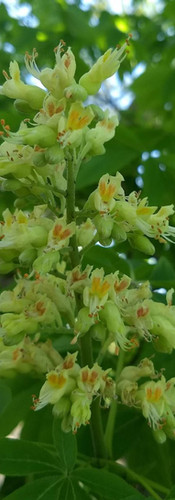Today we are spotlighting the native tree Ohio buckeye (Aesculus glabra) and comparing it to a similar introduced species, the horse chestnut (Aesculus hippocastanum). Both trees are in the Aesculus genus and have similar flowers, leaves, and fruits.
Leaves
Ohio buckeye (left) and horse chestnut (right) each have palmately compound leaves with five to seven leaflets that connect at a central point.
One way to tell these trees apart is by looking closely at the shape of the leaflets. Ohio buckeye have elliptic leaflets that are widest near the center and taper to a point at each end. Horse chestnut leaves are also pointed at each end, but the leaves are obovate, meaning they are oval shaped and the tip is wider than the base.
Both trees are pictured below in early spring. Ohio buckeye (center) will leaf out earlier in the year than horse chestnut (right).

Bark
Ohio buckeye (left) bark is light gray with a wrinkled appearance while horse chestnut (right) bark is light reddish brown with chunky flakes.
Flowers
Like their leaves, the flowers of the Ohio buckeye (two left images) are earlier bloomers than the horse chestnut (two right images). Both have showy pink and white flowers when mature that typically open in May throughout central Indiana.
Fruits
The fruit of Ohio buckeye (left) is a tan, bumpy, and somewhat irregular globe up to 2 inches in diameter. The fruit of Horse chestnut (right) is a similar size and shape, but is rounder and has spines.
Fall and Winter
Ohio buckeye (left) loses it leaves earlier in the season than horse chestnut (right).

Buds
The dormant leaf buds of both trees are large and easy to notice. Ohio buckeye buds (left) are longer. Horse chestnut buds are plumper and distinctly sticky.
Leaf Scars
Ohio buckeye leaf scars (left) are smaller than horse chestnut leaf scars (right). Horse chestnuts have seven distinctly visible bundle scars that line up in a horseshoe pattern. The bundle scars of Ohio buckeye are not as noticeable.
Ready to observe?
You can help scientists understand plants like Ohio buckeye and horse chestnut in Indiana by becoming a Backyard Observer.
Already an observer?
Download the phenophase guides for the Ohio buckeye and horse chestnut!
September Wrap-up
During September, observers used Nature's Notebook to report the presence of 42 species of birds and insects and reported on the phenophases of 134 species of plants at 24 observation sites around Indiana, collecting 6167 records!



























